Are you are tired of whole wheat flour that tastes bitter and is lacking in nutrients? Then it’s time to take control and start home milling your own flour using a manual or electric grain mill.
Why should you mill your own flour?
Your bread is only as good as the ingredients you use to make it! If you’re using processed flour, which includes additives and has been stripped of some or all of its nutrients, and you don’t know how long it’s been sitting on the shelf, then your bread, even when made from scratch, won’t be the healthiest substitute you want for your family.
When you grind your own flour, what you get is nutritious whole wheat flour where nothing has been removed (unless you sift out some of the bran). Whole wheat flour contains more nutrients because it retains the complete endosperm, meaning the bran and germ have not been sifted out as with white flour.
As you watch the grains go into the hopper and come out again as powdery flour, you’ll know exactly what you’re getting because you know what you put in it. You can be confident that you’re baking and feeding your family with nutritious flour with no fillers or additives.
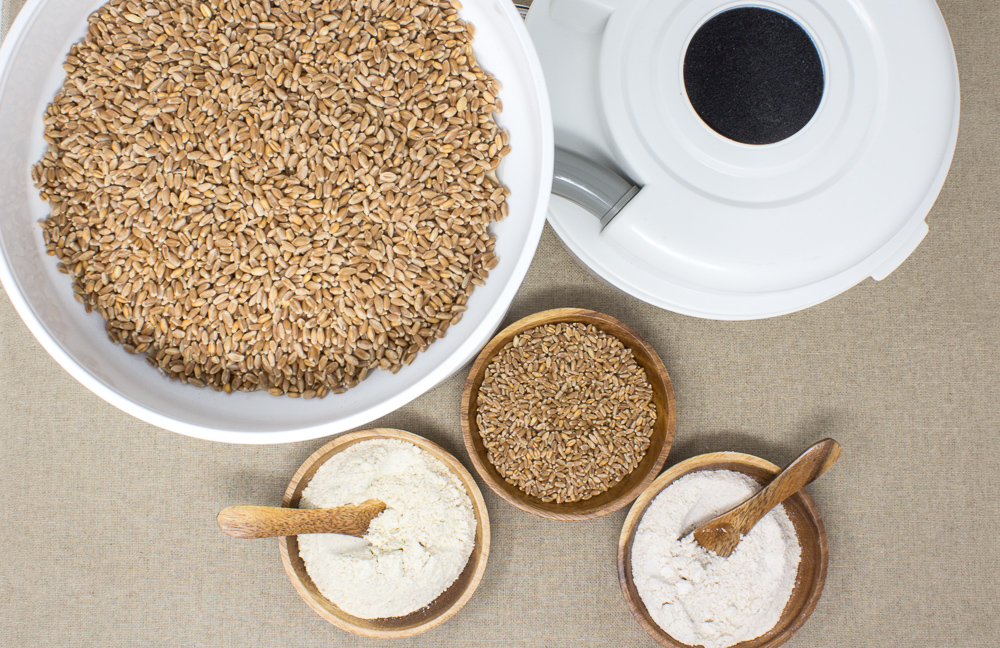
Some benefits of milling your own flour:
- Grinding your own flour is a unique and satisfying experience
- Having quality flour is a key ingredient in making healthy and flavorful homemade bread
- Freshly milled flour is sweeter than store-bought whole wheat flour
- Home milled flour tastes better and is better for you
- And, most importantly, when you mill your own flour, you know exactly what is in it, no hidden or unwanted ingredients.
What grains can be ground into flour using a grain mill?
A wide variety of grains, beans, seeds, and nuts can be ground into flour using your home grain mill. These include: wheat, rye, corn, rice, barley, oats, buckwheat, millet, KAMUT (Khorasan wheat), quinoa, peas, mung beans, garbanzos, and lentils.
- Split Green Peas Coarsely Ground
- Red Lentils Finely Ground
Raw wheat berries are the hulled whole kernels. You can use these to make home milled flours, or cook or sprout them to make breads. Grains can be white, russet, purple, or amber in color. You can also find Spelt, KAMUT, Emmer and Einkorn as whole grains. You can even grind popcorn for use in bread. It provides a very interesting texture and flavor.
- Oat Groats milled into flour
- Purple barley grains milled into flour
Selecting a Grain Mill for home milling your own flour:
There are a variety of grain mills on the market. Some are stand alone units, others attach to mixers, and some are hand cranked versus electric.
Tips for purchasing a Grain Mill:
- Buy a bread mill based on your intended usage
- If you are looking for a more hands-on experience, buy a manual grinder
- If you want the grinder to do the work, then an electric bread mill is a better choice
- Look for one that is easy to take apart and clean
When you mill your own flour, the possibilities are endless! Just keep in mind the quality of grains you use determines the quality of flour you’ll end up with. So start with a good quality grain, preferably organic.
Decide what type of grains or beans you want to mill into flour:
Hard red winter wheat and hard red spring wheat are the classic wheats used for yeast bread. However, you might want to try some of the ancient grains that are becoming popular and are said to be more nutritious and easier to digest. Spelt, Emmer and Einkorn grains are much healthier than modern wheats.
You can substitute these grains 1 x 1 for whole wheat flour in bread recipes although you’ll need to adjust the hydration and mixing times and depending on the recipe, you may need to adjust the amount of yeast used as well.
Tips for home milling your own flour:
- Only grind as much flour as you plan to use — freshly ground whole-grains get rancid very quickly.
- Whole grain kernels will keep at room temperature indefinitely.
- 1 cup of wheat berries produces a scant 1 3/4 cups flour.
- One pound of wheat berries equals approximately 4 1/2 cups flour.
- 2 Different types of Einkorn Grains
- Einkorn Milled into Flour
Whole grain bread recipes:
- Einkorn Bread Recipes
- Spelt Bread Recipes
- Sprouted Breads
- Whole Grain Bread Recipes
- Whole Wheat Bread using freshly milled flour
Learn more about whole grains & flours:
Types of Wheat – There are six main types of wheat grown in the United States. Within these different types of wheat, there are many varieties and sub strains that offer an array of possibilities for millers as well as bakers.
Types of Flour – Flour is the primary ingredient in bread. The kind of flour used will determine the nature of the loaf. The better the flour, the better your bread will taste. In this section, we list the main types of flour that can be used to make bread.
Wheat Flours – Wheat flours are the main ingredient in most bread products. Wheat is rich in gluten, a protein that gives dough its elasticity and strength. Learn more about wheat flours in this section.
Wheat Grains – By-products of milling white flours are unprocessed wheat bran and wheat germ. They add color, nutrition, and fiber to breads. Learn about other types of wheat grains that can be used in breads.
Non-Wheat Flours – There are a number of non-wheat flours that can be used as substitutes for wheat flour in breads. Wheat-free (gluten-free) flour can also be used in breads made with wheat flour to enhance the flavor and provide unique texture.
Organic Bread Flour – If you don’t want to get into home milling your own flour, try organic bread flour. It costs a little more than non-organic flour, but it is worth it! The bread baked with organic flour is better for you than most non-organic flour.
Sources:
Hensperger, Beth. The Pleasure of Whole Grain Breads. 2000. Chronicle Books.
Ingram, Christine and Shapter, Jennie. Bread: The breads of the world and how to bake them at home. Hermes House 2006.
Rehberg, Linda and Conway, Lois. The Bread Machine Magic Book of Helpful Hints. Second St. Martin’s Griffin Edition: November 1999.
Yutzy, Ray and Melinda. Wholesome Sugarfree Cooking. 2004. Carlisle Printing.
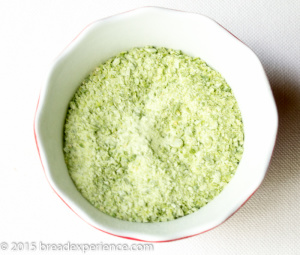
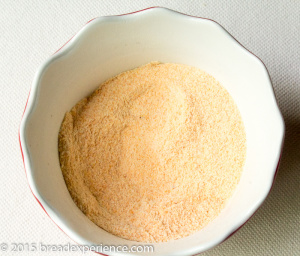
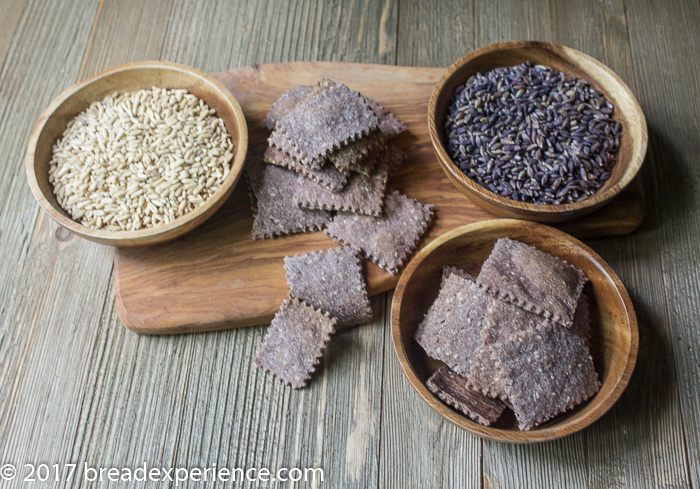
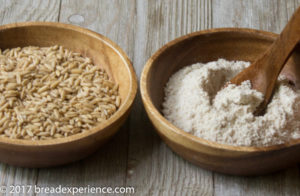
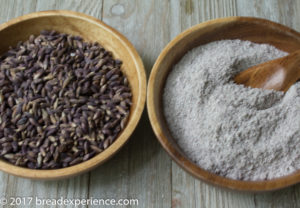
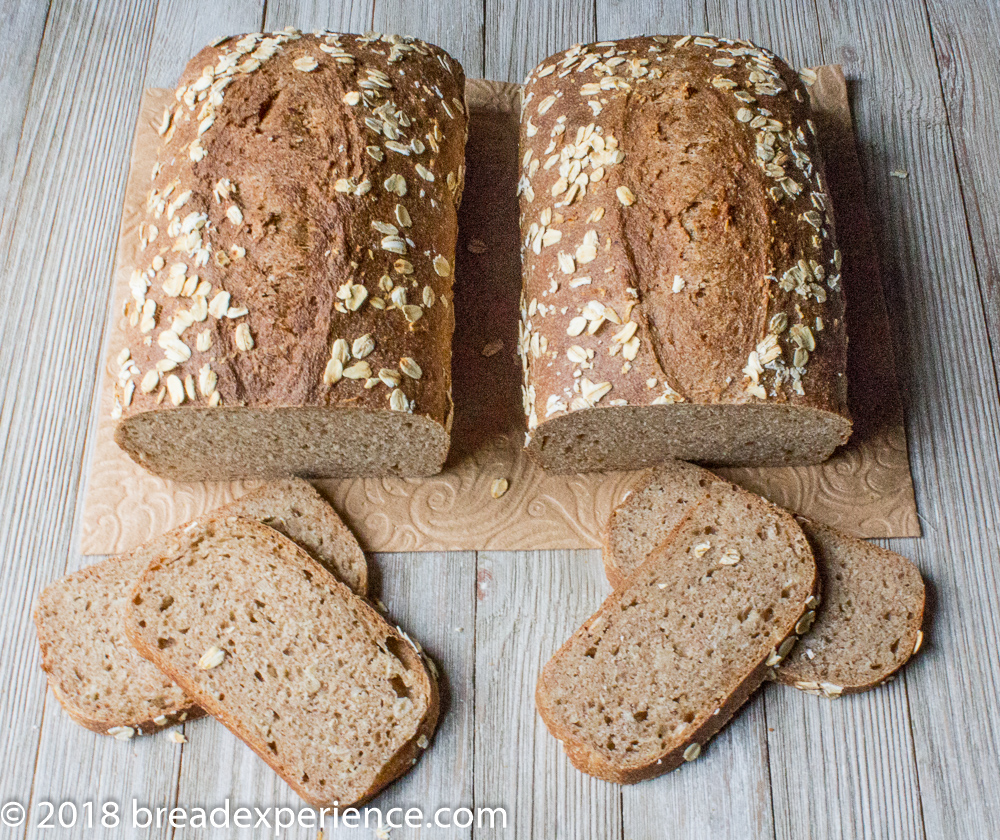
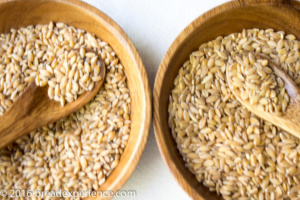
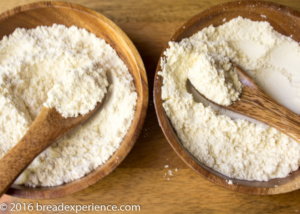

Emily says
What do you find to be the average turn around time to grind down say a kg (2lb) of flour? Thanks 🙂
Cathy says
Hi Emily, I use WonderMill grain mills to grind my grains into flour. I haven’t timed the process, but it is really fast. The manufacturer has performed tests which have shown that the WonderMill Electric Grain Mill can grind over 100 pounds of flour per hour and the Wonder Junior Hand Mill was able to grind 1 ¼ cups of flour in a single minute *80 turns*.
Leonard Armstrong says
I have an attachment on my Kitchen-aid Mixer and it works well. I can grind 2 cups of wheat berries/groats in 10 minutes, switch gears (literally) and be making bread in about 3 minutes. Grind as you bake so you don’t risk storing rotten flour or losing flavor freezing the flour. 2 cups whole = 3 cups (about) ground. Think coffee when milling. Grind only the amount you plan to use.
Cathy says
Hello Leonard, thanks for sharing the process you use for milling and using milled flour in bread. I’m glad you’ve found a method that works for you.
Angela Shuman says
What attachment would this be. I have a kitchen aide and would like to looke into this
Michelle says
Can you use a coffee grinder to achieve the same result?
steve says
our kitchen aide mixer broke will milling wheat berries
Cathy says
That’s a shame! I haven’t used the Kitchenaid grain mill attachment so I don’t have any experience with that, but I’ve been using my electric grain mill for years and it’s still working great!
Murray the Hun says
KitchenAide parts are available from appliance parts dealers. Mixer repairs are not that difficult, and there are many instructional youtube videos you can watch. Tools needed are simple. Just remember to use food grade lubricant (not necessarily kitchen aide brand) when you reassemble.
David says
I always used to grind my flour and use it straight away or freeze it straight away to avoid it going rancid. Then some years ago I was talking to a chemist at a big flour mill and she told me that when they supply flour to large bakeries in tanker loads they add an additive of some kind. This additive is a chemical that develops naturally over time but as the flour is made and delivered the same day there is no time for it to develop naturally, hence they add it. She recommended that I grind my flour and allow it to age at room temperature for about 10 days before either freezing or using, and this is what I now do. I have never had an issue with it going rancid in such a short time.
Cathy Warner says
Thanks for the info David!
Vera Hoff says
Just wondering what is the best way for me to clean the wheat berries before grinding. Our son raised some red wheat and brought some to his Mom to bake…and I want to be able to clean it without it taking too much time. I do have a mill.
Cathy says
Hi Vera, if your son threshed and winnowed and sifted the grains, I wouldn’t think they would need too much cleaning. You might want to check for small pebbles and sift them out.
Amy Burchett says
I just milled my first batch of berries! I am using the kitchen aid attachment. On the finest setting, I still noticed a large amount of the ‘bran’. Is it OK to make my bread dough with that or should I sieve it out?
Cathy says
Hi Amy, it’s okay to use the whole wheat flour with the bran. Depending on the bread you make, it could be denser. If you are looking for a lighter bread, then yes, you would want to sift out some of the bran. You might try it with or without sifting to see what you like better.
Bronwyn says
Way do you need a meel grinder
Cathy says
Do you mean is there something else you can use to grind wheat and other grains into flour? You wouldn’t get as fine a grind by using another method.
judith yongue says
I still son’t know what grinder to get. I would only need a hand operated on as this would be for a smalll family. what would you suggesgt?
Cathy says
Hi Judith, if you are looking for a hand grinder, then the Wonder Jr. Deluxe is a good grain mill to try. It clamps to a table and grinds grains into flour, but it can also grind oily seeds and nuts for nut butters. It does require manual work to turn the grinder but it might be fun for kids.
Jenn says
I love baking bread and my husband loves brewing beer. We’re both interested in getting a grain mill for our respective hobbies, but I’m wondering if anyone knows of a mill that would serve both our purposes? Most homebrew mills I’ve seen are designed for a coarse grind that breaks down the barley without creating a lot of powdery flour, whereas I, of course, WANT a fine flour. Does anyone know if such a mill exists with that kind of adjustable range?
Cathy says
Hello Jenn, the Wonder Jr. Deluxe Hand Grain Mill comes with 2 sets of burrs – stone and steel. The stone burrs are used mostly for grinding grains. The steel burrs will grind everything the stone burrs do as well as nuts, sprouts, beans, etc., however, the grind will be coarser using the steel burrs. The WonderMill Electric Grain Mill has grinding settings for pastry, bread flour and coarse flour.
Ace says
You should also be able to adjust the two grinding surfaces, closer for bread flours and farther apart for beer grains. Is your husband malting his own barley yet?
David Smith says
I have a Lee Household and it will make flour as fine as you can find in the store.
They are not cheap though.
I have had mine for 10 years
It is electric and has a pretty good size stone in it.
TLim says
where would you recommend purchasing high quality grains? I am trying to find a farm that does not use harsh chemicals and is organic and non-GMO. Do you know of any?
Cathy says
I buy organic non gmo grains. I don’t have a specific source to recommend – yet, but I’m working on it.
Jose says
Does anyone know if it’s ok to grind your wheat in a blender.I added whole wheat,flax seeds,oatmeal and chia seeds.Im using the flour for pancakes.
When I did this the processed flour came out better than the whole wheat flour I buy at the store.It was finer and easier to mix.Also the pancakes came out more fluffy.But I want to know if it’s an ok process or do I need a mill for this process?
Cathy says
Hi Jose, are you asking if wheat berries can be ground in a blender? It sounds like what you are doing is working, so use what works for you.
Fred says
Where can I but these types of special grains for milling? Is it much cheaper overall?
Thanks for the informative post! I love bread!!!! 🙂
Cathy says
Hi Fred, thanks for visiting. Glad you enjoyed the post. You can get wheat grains also known as wheat berries online or places like Whole Foods. Not sure where you are located. It can be cheaper overall, depending on what type of grains you get; however, the main benefit is that it is much better for you, especially if you use organic grains.
Nancy says
Hi .. I am hoping you can help me with this dilemma ! I have been grinding grains to flour for years, but this week it occurred to me that they have not been prewashed, even tho they are organic ! The health shop says their flours have been cleaned and suggested that I prewash all my grains , blot dry and air dry abit, then grind .. So, may be I should go back to buying organic flour , rather than doing it myself ? Can you please give me your opinion .. thanks
Cathy says
Hi Nancy, if you get your grains from a place you trust, then you probably don’t have to worry about it, particularly if you’re using organic grains. However, pre-washing the grains, then letting them air dry is certainly an option. Does the flour from the health shop taste different? You might try prewashing some grains to see how it does and then determine if it makes sense for you. As to whether you should go back to buying organic flour, that is up to you, but if you’ve been grinding your own flour for years, why would you want to stop now?
Diana says
I have a hand grinder. The result does not look like a fine milled powdery flour. Do I have to run it more than once?
Cathy says
Hi Diana, I’m assuming your manual grinder is a stone mill. If so, the ground whole wheat flour will be coarser. You can run it back through the grinder to see if it will grind more of the bran and germ, or you can sift out some of the bran to get a lighter flour. If you don’t want to sift it, another option is to increase the hydration of the dough to make the loaf less dense.
Teresa says
hi, I am new to this. I bought a mill but am wondering about the grains. D I want the hull on the grain or hulled grain to mill for flour for breads?
Thanks
Cathy says
Hi Teresa, congratulations on starting your home milling journey. For bread making, you need de-hulled grains which means the hull has been removed.
Teresa says
Thank you very much for answering me so quickly! I am excited about started thi!
Kevin says
I came across this article whilst looking for information about enzymes in green flour. Thought I’d leave a comment in the hope it leads people further forward with home milling. The results can be so superior to that of commodity flour.
Bolting with a 1mm mesh sieve will remove about 10% of the flour, all bran, but leave all of the nutrition germ. This will give a much lighter loaf and keep all of the goodness. Alternatively use some of the dough water to soak that bran over night, or hot to soak it for a few hours. this softened bran will not ‘puncture the gluten in the dough so much and will give a loftier loaf. (Allow for evaporation when calculating the water for the dough.
The wheat germ oxidizes over about the first 48 hours after milling as the germ is exposed to air. This means that freshly milled flour makes a dough with very much more goodness. The amylase groups convert the starch in the flour to malt. The yeast thrives in malt s this is a fermentation booster. It works exactly the same way as adding amylase or diastatic malt. However the side effect, just like with malt, is that the dough’s gluten becomes more extensible and less elastic. That is it does not hold its shape so well. This is fine for tin baking, but, for free form 2 – 4% of fava bean flour will toughen the gluten (make it more elastic) and if it is very bad reduce the water in the dough by 5% too.
BTW a 0.5 mm mesh sieve will take about 20 -25 % of the flour this is nearly all of the bran. This will give a very light loaf indeed, akin to a white bread, but without the flour being bleached, which I believe is fairly common for commodity white flour. Bleaching does all sorts of horrid things to the flour and is illegal in Europe.
Happy baking
Cathy says
Thank you for your comments. It’s always good to hear how other bakers are home milling their flour.
We definitely need to stay away from using commercial flour that has been bleached. Unbleached flour is the way to go.